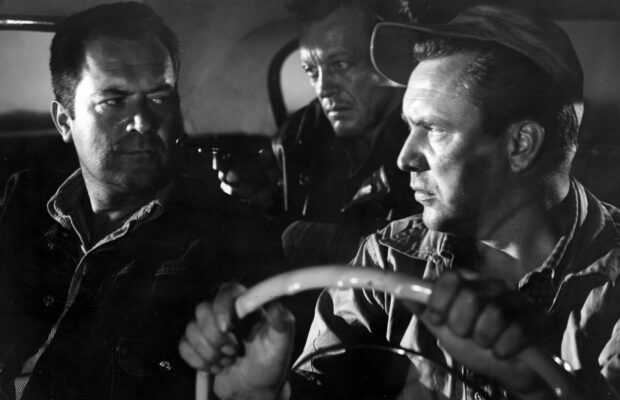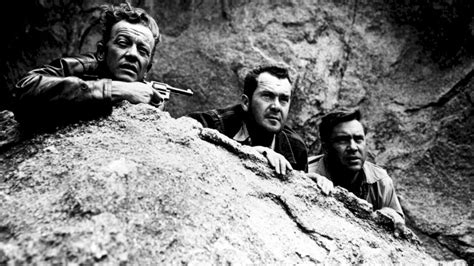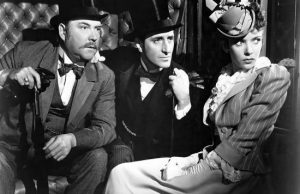The Hitch-Hiker (1953)

Toronto Film Society presented The Hitch-Hiker (1953) on Saturday, July 29, 2023 as part of the Season 75 Virtual Film Buffs Screening Series, Programme 10.
Producer: Collier Young. Distributor: RKO Radio Pictures. Director: Ida Lupino. Screenplay: Ida Lupino, Collier Young, Robert L. Joseph. Cinematography: Nicholas Musuraca. Film Editor: Douglas Stewart. Music: Leith Stevens.
Cast: Edmund O’Brien (Roy Collins), Frank Lovejoy (Gilbert Bowen), William Talman (Emmett Myers).
“You haven’t got a thing except that gun. You better hang onto it, because without it you’re nothing!” – Ray Collins speaking to his captor, Emmett Myers.
The Hitch-Hiker was the first – and arguably only – American film noir directed by a woman. The screenplay for the film was co-written with Robert L. Joseph and her then husband Collier Young and directed by Ida Lupino. Lupino and Collier also co-produced the movie through an alliance between RKO and their independent production company, The Filmakers, Inc. While this gave them some censorship latitude, Geoffrey Sherlock, a representative of Joseph Breen from the Motion Picture Association, still claimed The Hitch-Hiker breached the Production Code’s prohibition of screen depictions of contemporary, notorious criminals.
The film was initially influenced by The Persuader, a story written by Robert Joseph in which two ex-army buddies on a fishing road trip to Mexico pick up a shadowy male hitch-hiker on a deserted road. The Persuader was in turn based on the latter part of Daniel Mainwaring’s novel Build My Gallows High (1946), which Jacques Tourneur had adapted for the screen in 1947 as Out of the Past.
Daniel Mainwaring and Nicholas Musuraca were recruited from Out of the Past as screenwriter (uncredited, most likely because he had been blacklisted) and cinematographer respectively. Lupino revamped the story and changed the title first to The Difference, then to The Hitch-Hiker, most notably basing the Emmett Myers character on real-life 22-year-old psychotic serial killer William Edward Cook Jr., right down to his paralysed right eye.
Cook murdered six people, including a family of five, over 22-days in 1950-51 between Missouri and California, and was the target of one of the biggest manhunts ever launched in the United States. On December 12th, 1952, he was executed in the gas chamber at San Quentin State Prison having received the death penalty for his crimes.
Hoping to make the film more of a fact-based docu-drama, Lupino visited Billy Cook at San Quentin prior to his death, where he granted her exclusive rights to his story, however James V. Bennett, an official with the Bureau of Prisons, claimed that Lupino had obtained Cook’s release of the film rights without having gone through the legal channels of copyright clearance regarding convicted felons.
To appease both the Federal Bureau of Prisons and the Motion Picture Association, the story had to be more fictionalized with minimal attention given to the killing spree and the primary focus being on the two friends, Ray Collins (Edmond O’Brien) and Gilbert Bowen (Frank Lovejoy), who unsuspectingly pick up a madman during their travels. Still, to drum up audience interest in the film, RKO publicized it at the time of release as being factually accurate.

The 6th of eight films Lupino directed in her career, she succeeded in her aspiration to make an all-male noir in the style of her mentor Raoul Walsh. The opening shots of Myers from the waist down strip him of his humanity and set him up as a psychotic sadist (a harbinger of 1970s and 80s movie villains to come) brilliantly portrayed by William Talman.
He played the role so convincingly, in fact, that in an interview he recalled that while stopped at a red light in his convertible in Los Angeles, another driver in a convertible who was stopped next to him confirmed he’d portrayed the hitch-hiker in the film, got out of his car, slapped him across the face, then got back in his car and drove off. In recalling the story, Talman said, “You know, I never won an Academy Award but I guess that was about as close as I ever will come to one.”
While most noir films were shot in claustrophobic cities, The Hitch-Hiker was filmed in the desert landscape and small villages in and around Lone Pine California, the same location used for High Sierra. Lupino effectively used the confined quarters of the car, the bleak desolation of the desert, and the shadow and light around the campfire to enhance tension and fear in different scenes. Always interested in personal, human stories with intimate themes, she also draws out the believable portrayals of the two protagonists, ordinary men caught in a harrowing experience who foster a bond through the realization that the only way they have a chance of surviving is by staying together.
Lupino, who started her acting career at the age of 14 in England in 1931’s The Love Race (a part for which her mother had previously tested) and continued to act to fund her and Collier’s production company, cited The Hitch-Hiker as the favourite of those she directed. It was also, however, one of her greatest disappointments. Considered a B Movie by RKO, no longer in its heyday and being run by Howard Hughes, it was made in about 5 weeks on a budget not much higher than $100,000, printed on cheap film, released to little fanfare, and played as a double-bill second feature.
Fortunately, the film was restored in 1997 bringing back to life the effects and subtlety she had worked so hard on with Musuraca, and in 1998 The Hitch-Hiker was selected for preservation by the National Film Registry in the United States as being “culturally, historically or aesthetically significant.”
At the time she was directing, Lupino was asked ad nauseam how a male cast would respond to a woman giving them orders on set. One article from 1958 headlined “Taking Orders from a Gal Is OK if She’s Ida Lupino” quoted Frank Lovejoy endorsing his “gal” director: “She’s the prettiest director I’ve ever worked for. And I’d like to say that it was a pleasure to be able to call my director ‘honey’ and ‘doll’.” Lupino admitted to often pretending to a cameraman to know less than she actually did, stating “that way I got more cooperation”. Despite suffering through this sexist behaviour, she despaired that more women in Hollywood weren’t directing and producing films and encouraged others to do it.
Running at just over 70 minutes long, The Hitch-Hiker moves at an intense clip and is devoid of filler scenes and backstories. The ‘bad for the sake of it’ villain has become ubiquitous over the decades, but through the character of Myers, Lupino introduced a new kind of villain. This is just one of many ground-breaking accomplishments of a woman who rivalled her male counterparts during Hollywood’s Golden Age.
Notes by Kathleen McLarty
Sources: https://www.sensesofcinema.com/2018/cteq/the-hitch-hiker-ida-lupino-1953/
https://en.m.wikipedia.org/wiki/The_Hitch-Hiker
https://vimeo.com/115654062
https://m.imdb.com/title/tt0045877/
https://www.gartenbergmedia.com/dvd-distribution-and-sales/genre-films/the-hitchhiker
https://www.sensesofcinema.com/2018/cteq/the-hitch-hiker-ida-lupino-1953/
https://screen-queens.com/2020/02/21/wihm-the-hidden-polemic-of-ida-lupinos-the-hitch-hiker/
https://www.classicfilmnoir.com/2019/08/the-hitch-hiker-1953.html










[…] (1932), Kansas City Confidential (1952), And Then There Were None (1945), Royal Wedding (1951), The Hitch-Hiker […]